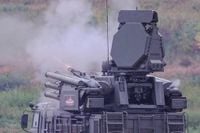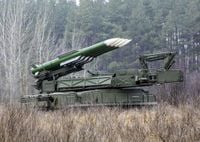On May 6, 2025, the skies over Moscow were anything but peaceful as Russian air defense forces engaged in a series of operations to repel drone attacks from Ukraine. According to Moscow's mayor, Sergei Sobyanin, the air defense systems were active throughout the day, successfully intercepting multiple Ukrainian drones aimed at the capital.
Between the hours of 17:38 and 22:52, Sobyanin reported that eight Ukrainian drones were shot down while approaching Moscow. He confirmed that two of these drones were intercepted directly over the city. "The air defense forces of the Ministry of Defense repelled an attack by two drones flying towards Moscow," Sobyanin stated, emphasizing the ongoing threat posed by these unmanned aerial vehicles.
Details from the Telegram channel Shot revealed that one of the drones was destroyed over Noginsk and the other over Shchelkovo. Fortunately, there have been no reports of casualties or damage resulting from these incidents. However, the airspace around Moscow was heavily impacted, leading to temporary flight restrictions at several regional airports, including those in Nizhny Novgorod, Kaluga, Tambov, and Yaroslavl, as reported by Rosaviatsiya.
The situation escalated earlier in the day when an air raid alert was declared in Ramenskoye, a city in the Moscow region. This marked the second drone attack in the area within a 24-hour period. The Ministry of Defense reported that overnight, their air defense systems had successfully destroyed and intercepted a staggering 105 Ukrainian drones across 11 regions, including 19 drones specifically over Moscow and its suburbs.
As residents of Shchelkovo and Losino-Petrovskoye reported on the operation of air defense systems, they described experiencing disruptions in mobile service and hearing sounds resembling explosions, indicating the active engagement of air defense measures. Local sources suggested that the drones targeted in these attacks were likely reconnaissance drones of the Lyutyi type, further complicating the security landscape in the region.
In a related development, earlier in the day, an alert for a UAV attack was also announced in the Ryazan region, underscoring the extensive reach of the drone campaign. The Ministry of Defense confirmed that two Ukrainian drones were indeed shot down over the Moscow region, with the same details corroborated by Shot, which noted the use of Lyutyi drones in these attacks.
As the day unfolded, the Russian authorities remained on high alert, with air defense systems continuously monitoring the skies for further incursions. The incidents reflect an ongoing pattern of drone activity that has become increasingly common in the region, raising concerns about the potential for further escalation in hostilities.
Experts have noted that the use of drones in warfare has changed the dynamics of conflict, allowing for reconnaissance and targeted strikes without the need for conventional military engagement. This shift has prompted nations, including Russia and Ukraine, to bolster their aerial defenses in response to the growing threat posed by unmanned aerial vehicles.
As the situation continues to develop, residents in the affected areas are left to navigate the complexities of living under the shadow of ongoing military operations. The sound of explosions and the sight of drones in the sky have become a part of daily life, forcing many to adapt to a new reality marked by uncertainty and fear.
While the Russian government has portrayed these defensive actions as successful, the ongoing drone attacks highlight the persistent challenges faced by both sides in this conflict. The ability of Ukrainian forces to launch such attacks indicates a level of operational capability that continues to pose a threat to Russian security.
As the international community watches closely, the implications of these drone engagements extend beyond the immediate conflict, raising questions about the future of warfare and the role of technology in modern military strategies.
In summary, the events of May 6, 2025, serve as a stark reminder of the volatile situation in the region, where drone warfare has become a central feature of the ongoing conflict between Russia and Ukraine. With both sides demonstrating their capabilities in the air, it remains to be seen how this will influence the broader geopolitical landscape.





